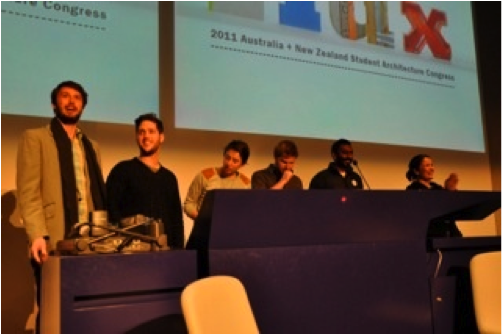
Left to right: Thomas Marshall, Joe Larkings, Jess Miley, Sean McEntee, Sam Jeyaseelan, Rianda Barnes.
Image: Michael Ford
The Australia, New Zealand and Papua New Guinea Student Architecture Congress, held between university semesters, serves to kickstart the architectural metabolism of the student, oft-malnourished from their studies. Flux 2011 descended on Adelaide in July with a timely delivery of ideas that proactive students who attended appreciate as formative to their knowledge of how architecture can react and adapt to current world circumstances. This, surely, is the essence of a student congress.
The Newcastle directors wish to congratulate the directors of Flux 2011 on this successful event. The involvement of the Australian Institute of Architects in the organization and running of the congress has been the subject of some opinion, yet the relegation of a profession willing to support its students would have been counterproductive. As students, we always have the right to evaluate the profession we are about to enter into, but a willing partnership can benefit education and the profession alike. The student congress has always been, and will continue to be, a forum for architecture students to actively take control of their education and focus on the issues we find pressing within our society and profession.

Flux 2012.
Image: Michael Ford
In Canberra, at Re:hab 2009, the winning bid for Adelaide pitched a congress that promised to show architecture’s response to crises. Post Victorian bushfires, this crisis congress was only reinforced throughout the following two years by a series of previously unthinkable world events; flood, earthquake and tsunami provided an unfortunate wealth of potential topics to explore. Dr Ken Yeang and Nathanial Corum, international keynotes, Paul Pholeros and the a panel from the International Network of Indigenous Architects provided poignant expressions of a profession much more broad and responsive than might be considered by some students, who may be blinkered by the impending business of the built environment, which at cursory glance can sometimes seem impenetrable and slow to act and react.
Richard Briggs’ work in the postcolonial Solomon Islands with Emergency Architects Australia was particularly inspiring. Rapid assessment and flexible design, coupled with skills transfer to local craftspeople resulting in community mobilization, was impressive. As a student, the ability for architecture to be so intensely empowering was reassuring.

Flux 2012.
Image: Michael Ford
The crisis sessions provided by the organizers went further than immediate disaster scenarios and the variety of perspectives kept students’ interest throughout the three-day block of talks. Melonie Bayl-Smith and Charles Holland engaged students in examples of the architectural practice in crisis, through economic downturn and an architectural education that has, allegedly, divorced itself from the act of construction and material experimentation.
Perhaps what was needed in some of the addresses was an engagement with what it means to be an architectural student in the present day. Regrettably the Student Organised Network for Architecture (SONA) student forum was cut short, a double-edged sword that allowed time for the three congressional bids for the right to host in 2013. The Newcastle team won the vote of the caucus over a worthy bid for Melbourne and an inspired bid to take the congress to Alice Springs.
Looking towards 2013, the first time the congress is to take place in Newcastle, is to focus on some major issues that face many regional cities around the world in the twenty-first century. Flux 2011 focused on reaction to more “instant” disasters – flood, earthquake and fire; however, there is a status quo in many cities around Australia and the world that often leaves the in-between regions forgotten and overlooked. Newcastle is Australia’s largest regional city and the best example of the worst of circumstances. Newcastle’s history, which encompasses riots, earthquake, the shutting down of industry and floods, has resulted in a present-day city that is at once one of the best places to live in the country, yet with an emptying CBD; it is in danger of having a dead heart.
In times of crisis and hardship, however, the arts has come to the fore, to give a voice to the concerns of the people being affected by the state of their city. Reacting to grassroots movements, like Renew Newcastle and This Is Not Art, this congress will be about the regeneration of urban space. Newcastle 2013 will be an opportunity for architecture students to actively engage in this urban and regional condition, enjoying speakers, installations and workshops from a range of professions.
The directors of the next Australia and New Zealand Student Architecture Congress, to be held in Newcastle 2013, are Rianda Barnes, Wen Harn Chung, Joe Larkings, Thomas Marshall and Theodora Woodward.














